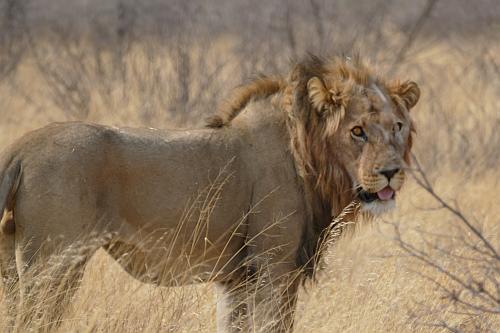
(Almost) no people, with the roof tent in the Kalahari.
Central Kalahari Game Reserve
The CKGR is the second largest game reserve in the world and with 52 800 km2 larger than Denmark. It is located in Botswana, in the heart of the Kalahari. The landscape is mostly flat, with bushes, grass, sand dunes and occasional large trees. Four former rivers, fossilized into salt flats, cross the reserve.
The park is home to black-maned Kalahari lions, giraffes, sable hyenas, warthogs, cheetahs, wild dogs, leopards, blue wildebeest, eland, spitbuck, kudu and red hartebeest.
The San people inhabited the area from time immemorial as nomadic hunters. Diamonds were discovered in the reserve in the early 1980s. In three large expulsion campaigns 1997 - 2005, the San were driven out of the reserve. They lived in resettlement camps outside the reserve from then on. In the most expensive legal battle in Botswana's history, the San were granted the right to return to their ancestral land in 2006. However, the Botswana government made it difficult for the San to access clean water, forcing them to travel long distances to access drinking water. After further negotiations, they were finally granted the right to water in a historic ruling in January 2011.
Deception Camp (9/15/2016)
The entrance to the park is overwhelming. After the drought of the last 200 km, we did not expect this. The grass of the pan shines in bright golden yellow for kilometers. Still 50 km to the campground. With the help of GPS coordinates and some detours we find our camp-site in Deception Valley. The other five sites within a radius of 500 meters are empty. The next person is at least 50 km away.
No sooner have we parked than we are loudly greeted and harassed by a large family of Red-billed Spurfowls (a partridge species). Chairs, grill pan and tent canvas are immediately seized. They even accompany Klaus to the outhouse. With a bowl of water we lure them away and enjoy the endless expanse and the southern starry sky at full moon. On all campsites we are also almost always visited by the Yellow billed Hornbill and chipmunks. The squirrels have entire areas covered with their extensive cave systems. The snapshot of a weasel was the only sighting of this animal on our trip. Sabine poses in front of a particularly impressive termite burrow.
Passarge Camp (9/16/2016)
The huge grass pans, almost devoid of trees and bushes, offer the best opportunities for wildlife viewing.
Today we plan to drive along some of these pans and slowly work our way up to our destination, Passarge Pan.
We will see a large gathering of wildlife in a pan for the first time in the Tau Pan. In the morning light simply breathtaking. Klaus registers a movement some distance away under a group of umbrella acacias. Through binoculars it turns out to be a safari vehicle from Kwando Safaris, who operate Tau Lodge. With 450 €/night/person at the moment not our price range. We drive straight there, after all, you never know why they stop there. The guide Ian, a former professional photographer, invites us to follow him and his Asian tour group and leads us to a group of male lions that we would never have found without his help.
As we continue our journey, we briefly get lost and only find our way back to the "right path" with the help of the GPS after a few failed attempts.
We meet a two Swiss, who spend the night on the neighboring campground (21 km away). They invite us for coffee the next morning, which we gladly accept.
In the evening while writing the blog suddenly Sabine screams. A gopher has probably held her painted toenail for a nut and bit into it. That really hurts!
Sunday Camp (9/17/2016)
The night was pleasant, it doesn't get cold and windy again until morning. No animal tracks in the sand; only the meerkats guard us.
On the way to Sunday Pan we stop at our new neighbors Iris and Peter from Bern, who travel the continent since 1973.
In the early afternoon we reach Campsite 3 in the Sunday Pan. From there its only a short way to a waterhole, well placed under a tree. We wait for the things to come. Plenty of animals show up.
Here are some more photos:
The first giraffes on this trip. For the first time ever we saw bat-eared foxes. And finally, a look at the sanitary facilities at Sunday Camp, which are positively different from the previous ones (no water connection, of course).


